Physical Address
304 North Cardinal St.
Dorchester Center, MA 02124
Physical Address
304 North Cardinal St.
Dorchester Center, MA 02124

Short on square footage? These small garden ideas transform any balcony garden, windowsill, or micro patio into a lush escape. Explore vertical gardening with a sturdy vertical planter, mix-and-match container gardening, and sprinkle in tiny patio plants for color and texture. Try railing planters for instant curb appeal, an herb garden kit for fresh flavor, and a compact watering can that tucks away neatly. No sun? A discreet grow light keeps greens thriving. From space-savvy hacks to stylish setups, discover clever, doable ways to grow big joy in tiny spaces.
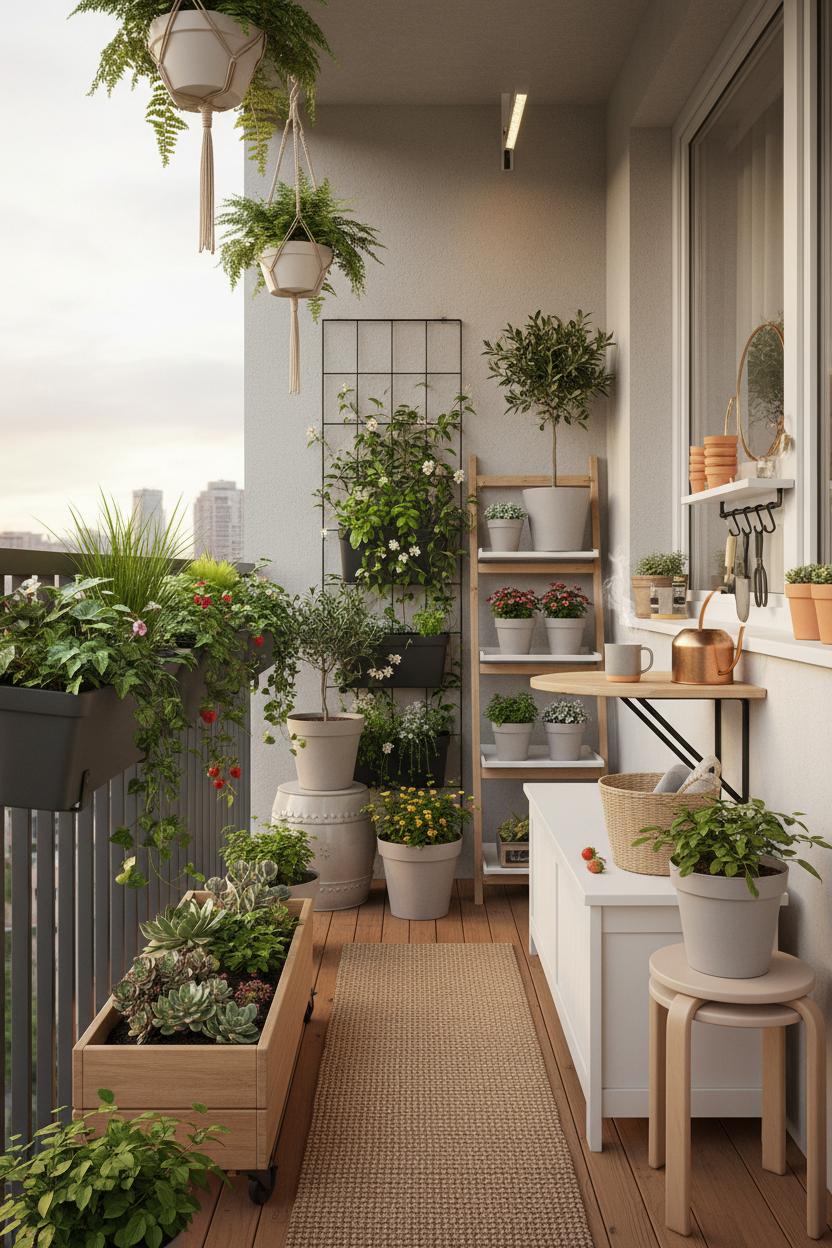
Start by thinking in layers, not square footage. In a balcony garden or petite patio, the smartest small garden ideas are all about opening the floor while letting the plants rise. Keep the center as clear as possible, then build green “edges” along walls, rails, and corners. A slim bench with hidden storage doubles as seating and a potting perch; a fold-down bistro table mounts to the wall; hooks keep tools up and out of the way. Embrace vertical gardening to pull the eye upward—tall trellises, a vertical planter, ladder shelves, and hanging pots create a living backdrop without stealing your precious steps. Containers become modular furniture: use nesting stools as stands, tuck wheeled troughs under a window, and cluster tiny patio plants in threes to look lush but tidy.
Work with a simple palette—two materials, two pot colors, one accent hue—so your container gardening reads as intentional, not cluttered. Along railings, swap bulky boxes for sleek railing planters; they frame the view and free up floor space for a narrow runner or stepping stone path that guides movement on even the smallest deck. Layer heights with the thriller-filler-spiller method: a compact olive or bamboo as the thriller, herbs and dwarf perennials as fillers, and trailing ivy or strawberries to soften edges. If you love kitchen greens, an herb garden kit on a sunny shelf keeps basil, mint, and thyme right at reach; pair it with a compact watering can that tucks into a basket so supplies stay pretty, not messy. For micro-nooks, think vertical stacks of succulents, trailing pothos, and ferns; for sunnier spots, dwarf tomatoes and chilies shine in tall planters.
Light is your secret design tool. Bounce brightness with a mirror or pale pots, and if your space leans shady, a discreet grow light under a shelf extends your season without turning the area into a science lab. Repeat plant textures from low to high—feathery grasses at your feet, a mid-level fern, then a climber overhead—to stretch the space visually. Finally, plan micro-zones: a morning coffee corner, a sunset perch, a tiny potting corner on a tray. With thoughtful stacking, clean lines, and a few well-chosen pieces, even the smallest balcony becomes a layered garden room.
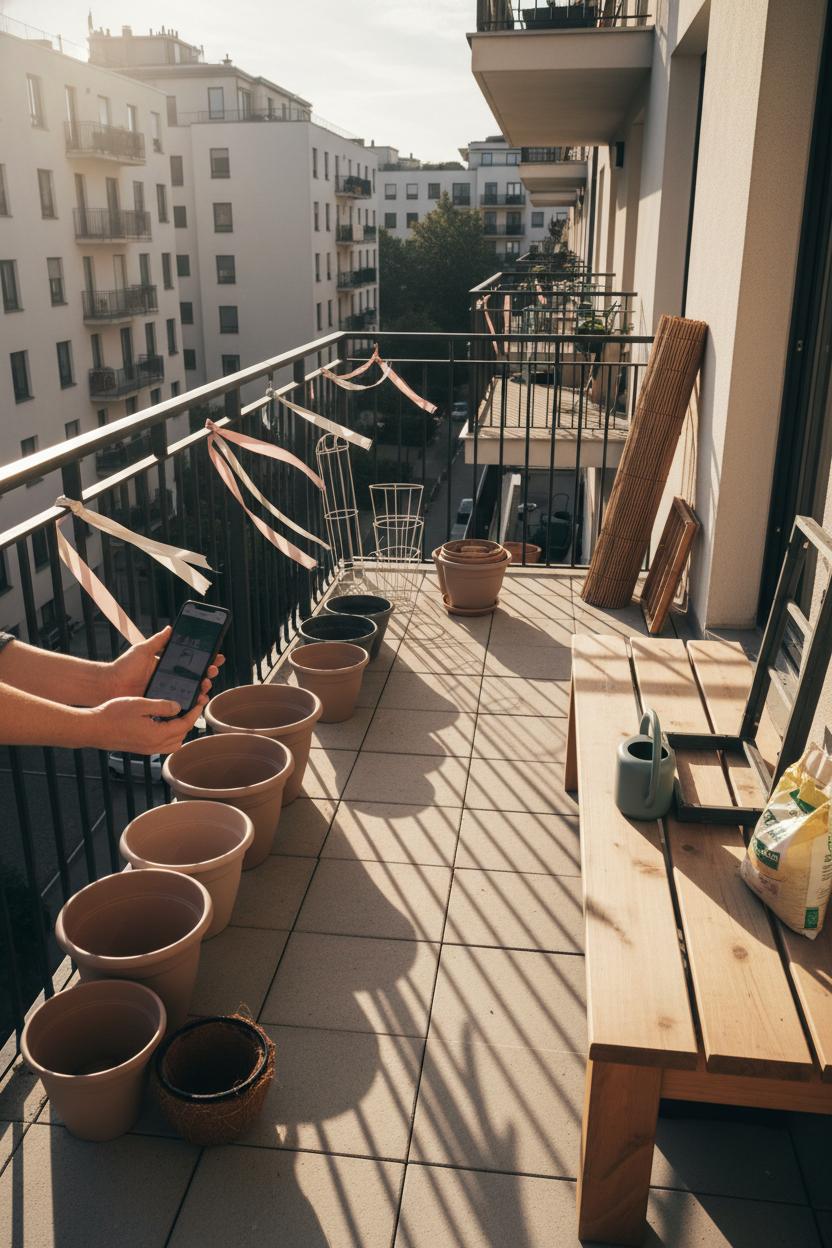
Before you buy a single pot, take a quiet morning to watch how the sun actually moves across your balcony garden, because light is the first ingredient of every thriving little jungle. Note the hours of direct sun, the dappled moments, and the shady stretches created by neighboring buildings or railings; a simple phone light meter or the old-school hand-shadow test works wonderfully for this. South and west exposures suit sun-lovers, while east-facing corners are gentle and perfect for tiny patio plants like lettuces and herbs. If your space is mostly bright shade, layer in a discreet grow light for an evening boost, or try vertical gardening so sun-seekers sit higher while shade-tolerant greens tuck lower in a slim vertical planter. These small garden ideas help every leaf find its sweet spot without hogging precious square footage.
Weight comes next, and it matters more than most people realize. Wet soil is heavy, so check your building’s load guidelines and aim for lightweight materials: resin or fiberglass pots, coco coir–based mixes, and plenty of perlite for fluffy, drainable volume that doesn’t strain the structure. Self-watering inserts cut both watering chores and water weight swings, and railing planters save floor space while distributing weight along the strongest parts of the balcony—just secure them with proper brackets. When in doubt, think layers rather than heft; a slim vertical planter filled with herbs and strawberries can replace a single giant pot. Keep a compact watering can on hand so you’re not lugging buckets around, and remember that container gardening loves routine—consistent, gentle waterings keep roots happy and floors light.
Finally, make friends with the wind. Balconies can channel breezes into mini wind tunnels, so do a ribbon test—tie a piece of ribbon to the railing and watch where it whips. Use trellises, reed screens, or even a bench to create soft windbreaks, and choose plants with flexible stems and small leaves: rosemary, thyme, chives, alpine strawberries, and sedums are resilient stars for container gardening. Cluster pots for stability, keep taller growers staked, and favor low, wide containers over tippy ones. If your windiest days still feel wild, start an herb garden kit on a sunny windowsill and rotate harvest-ready pots outside on calmer afternoons. With a few thoughtful tweaks, your balcony garden becomes a sheltered, sky-high oasis brimming with small garden ideas you’ll use all season long.
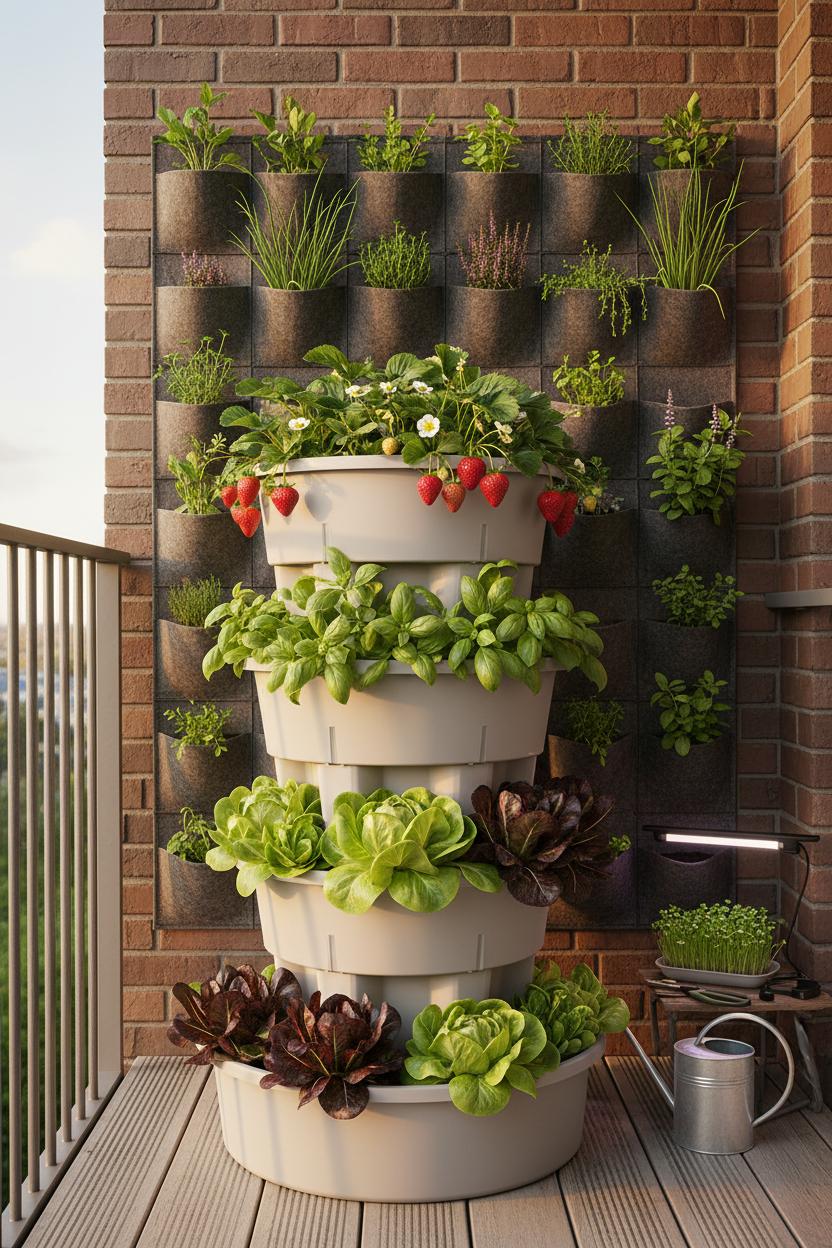
When floor space is precious, vertical gardening feels like a little magic trick—suddenly your walls, rails, and corners become lush and useful. Think of a vertical planter as the backbone of a petite, living tapestry, whether you’re styling a sunny balcony garden or a narrow side porch. Start by deciding where your garden will live: mounted on a wall, perched on a railing, or freestanding. For renters, modular stackable towers are easy to move and great for lettuce, strawberries, and trailing flowers, while felt pocket systems make herbs and tiny patio plants look like a green quilt. If you have sturdy rails, railing planters turn wasted edges into productive rows. Love climbers? A slim trellis paired with small pots gives peas and cucumbers a place to stretch without stealing floor space—a favorite among my small garden ideas for tight patios.
Materials and watering matter as much as the look. In hot, exposed spots, UV-stable plastic or powder-coated metal with good drainage keeps roots happier than heavy ceramics; for indoor walls, choose felt pockets with a moisture barrier to protect paint. Built-in reservoirs or wicking inserts reduce how often you water, and a compact watering can with a narrow spout helps you reach upper tiers without drips. If you’re just starting an herb stack, a simple herb garden kit slipped into a vertical planter makes setup foolproof. Use lightweight potting mix made for container gardening so roots can breathe, and add a saucer or drip tray if your landlord is railing-drip sensitive. Always check weight limits and use proper anchors—wet soil is heavier than it looks.
Plant to your light. Sun-drenched spots love compact tomatoes, chilies, strawberries, and bush basil; partial shade suits mint (give it its own container), parsley, chives, violas, and trailing thyme. Succulents and peperomias are gorgeous low-water fillers for the top tiers, while baby greens and microgreens thrive closer to eye level where you’ll harvest often. For dim corners, clip on a slim grow light to keep everything perky. Rotate your towers every week, snip and snack as you go, and refresh tired pockets seasonally. With the right vertical planter and a little rhythm, even the teeniest nook becomes a stacked, fragrant oasis—and your tiny patio plants will look like a Pinterest dream.
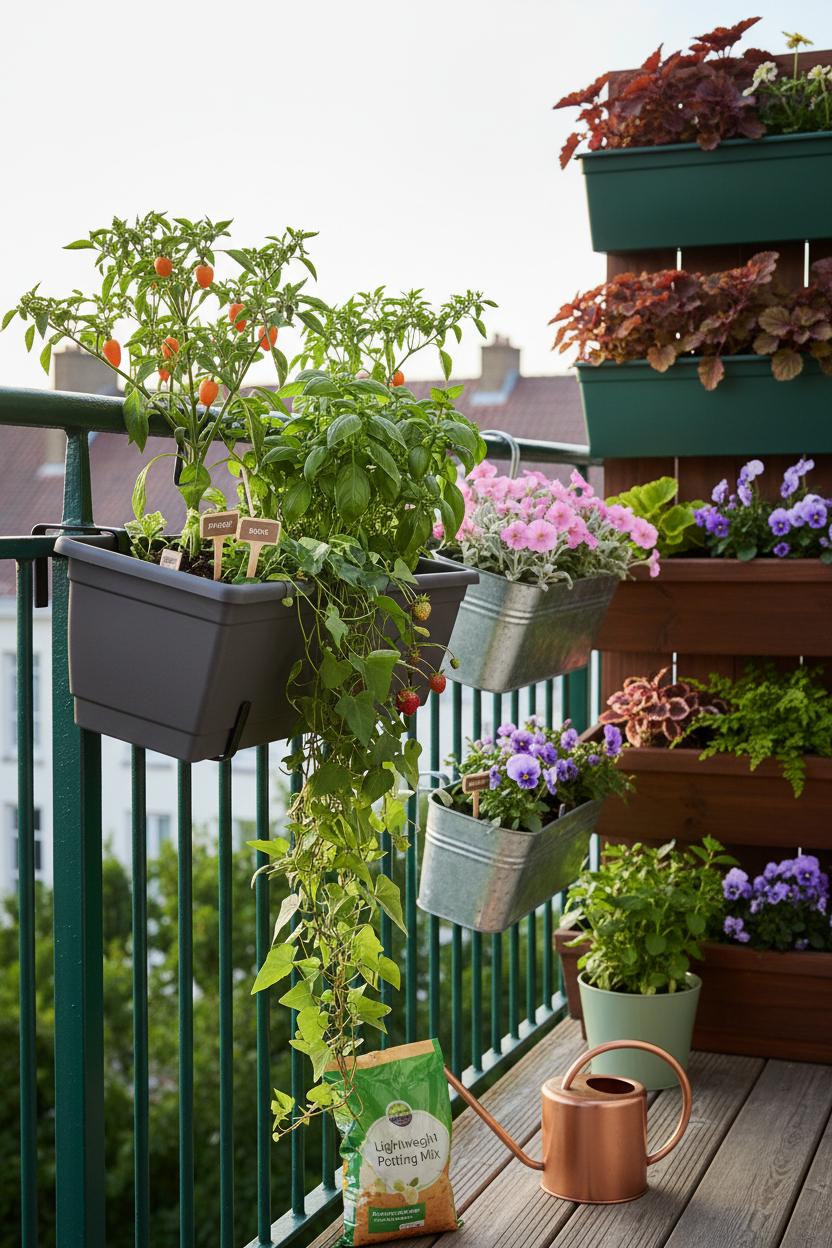
Railing planters are the ultimate space-smart upgrade for a balcony garden or porch, turning that overlooked rail into a ribbon of color, scent, and fresh flavor. Think of them as mini window boxes with a view: sleek troughs that straddle the banister, deep pockets that hug the top rail, or bracket-style baskets that hang neatly inside the safety line. They’re tailor-made for container gardening in tight quarters, and they play beautifully with vertical gardening if you add a slender vertical planter in a corner for extra height. For tiny patio plants, try a “thriller-filler-spiller” mix—upright thyme or dwarf chili as the thrill, bushy basil or compact zinnias for fill, and trailing strawberries, sweet potato vine, or creeping rosemary to spill over the edge. It’s one of those small garden ideas that instantly feels boutique and curated without sacrificing precious floor space.
A few practical notes keep things easy and tidy. Measure your rail before you buy railing planters, and look for designs with adjustable brackets and built-in saucers to catch drips. Lightweight potting mix and slow-release fertilizer keep containers from getting heavy. Water with a compact watering can that has a long, narrow spout so you can reach each planter without splashing your neighbors. South-facing rail? Go sun-lovers: dwarf tomatoes, oregano, and calendula. Shady porch? Lean into ferns, ivy, mint, and edible flowers like violas. If your balcony is more twilight than daylight, clip on a discreet grow light to keep herbs perky through cloudy days.
For a functional flourish, dedicate one planter to an herb garden kit—parsley, chives, and basil at arm’s reach for weeknight cooking. Repeat a tight color palette (all soft pinks and silvery greens, or spicy oranges with glossy green herbs) to make the railing read as one cohesive design. Mix textures—matte terracotta-look planters next to painted metal—to add depth without clutter. Swap in seasonal stars: spring pansies, summer nasturtiums, fall heuchera, winter-hardy evergreens. And if privacy is precious, stagger two or three planters along the rail to create a leafy screen that still lets breezes through. Simple, stylish, and surprisingly productive, railing planters prove that the best small garden ideas often live right at the edge.
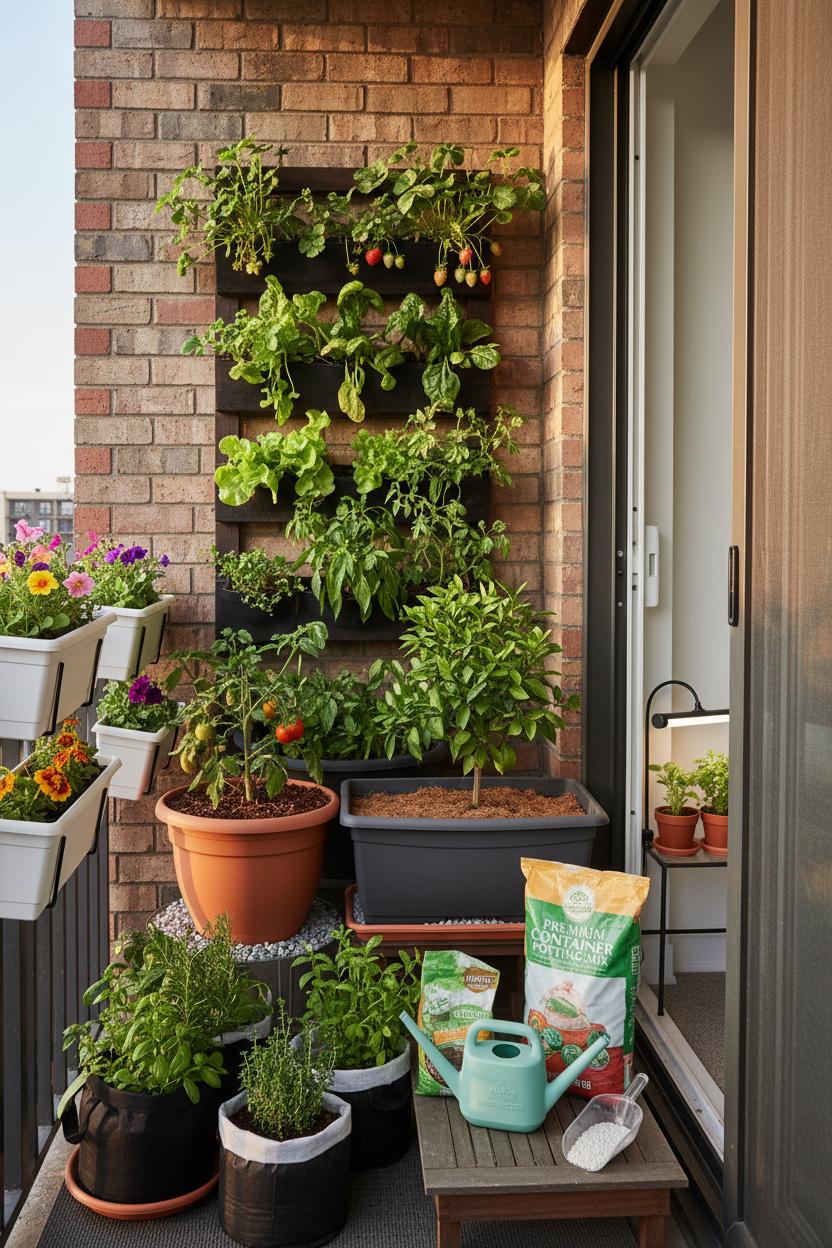
Great container gardens start with great soil, so think light, airy, and rich rather than heavy. Skip the scoop from the yard and reach for a high-quality potting mix labeled for containers; it’s blended to drain well while holding just enough moisture. I like to fluff mine with a scoop of perlite or pumice and a handful of compost for slow, steady nutrition. If you’re growing hungry veggies in your balcony garden, tuck in a slow-release fertilizer at planting time and top with a thin mulch of shredded bark or coco coir to keep the surface from drying out. This simple soil recipe is the backbone of container gardening, helping roots breathe and thrive in tight quarters—perfect for tiny patio plants that need to work extra hard in smaller pots.
Drainage is everything. Choose pots with generous holes, and resist the old “layer of rocks” trick—it actually slows drainage. Instead, line the bottom with a scrap of mesh or a coffee filter to keep soil in and water flowing out. Set pots on feet or a slim plant stand to let air circulate beneath, and use saucers with a little pebble layer to catch runoff without leaving roots soggy. When watering, go slow and even, letting it trickle until you see a steady stream from the base; a compact watering can makes this tidy and precise. If your balcony is breezy or sun-baked, water in the morning and consider self-watering inserts. On shared railings, choose sturdy railing planters with secure brackets and a drip tray to keep neighbors happy.
For pot selection, match the container to your plant’s thirst and size. Terracotta breathes and looks timeless, but dries fast; plastic and lightweight resin hold moisture longer and are balcony-friendly; fabric grow bags are great for herbs and salad greens. Go wider and deeper than you think—roots love room. Leafy greens and strawberries are content in shallower pots, while tomatoes, peppers, and dwarf citrus want depth. To stack more life into small garden ideas, try a slim vertical planter against a wall for vertical gardening, and cluster a starter herb garden kit by the sunniest door. Low light indoors? A clip-on grow light keeps basil and mint lush. Mix textures and heights, tuck in seasonal color, and watch your compact jungle flourish.
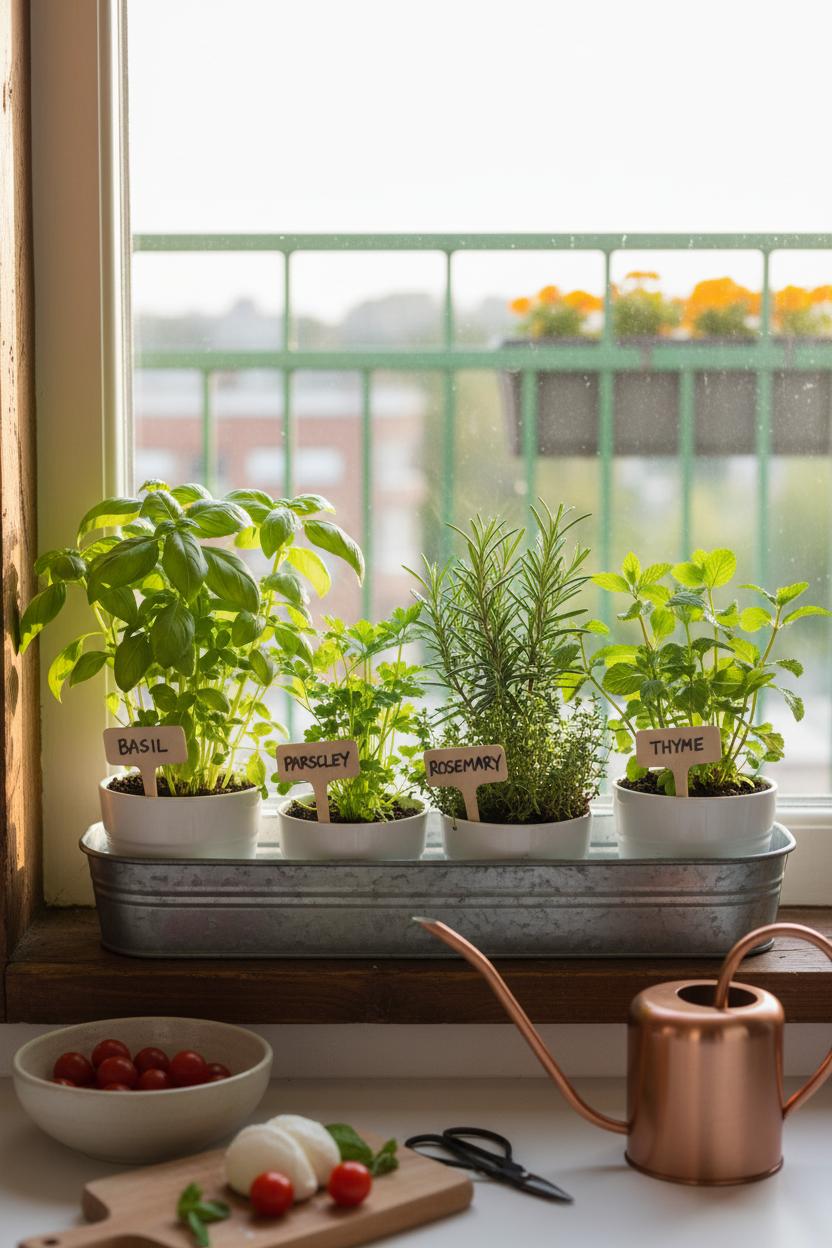
Nothing beats the thrill of snipping a few emerald sprigs right where you cook. A simple herb garden kit turns a sunny windowsill into the freshest corner of your home—no yard required. Unwrap the little pots, expand the soil disks with warm water, and tuck in seeds of basil, parsley, mint, or thyme. Label them, nestle everything into a drip tray, and set the lineup where the light lingers. This is container gardening at its coziest: compact, pretty, and endlessly useful. A south- or west-facing window is ideal; rotate the pots every few days so your herbs grow upright and lush, and don’t be shy about pinching the tips to encourage bushiness and flavor.
If your kitchen is short on sun, clip on a slim grow light to keep the greens perky through darker months. Water gently at the soil line or from the bottom so roots drink what they need; a compact watering can with a narrow spout helps you avoid splashes on the sill. Keep things tidy by trimming regularly—little harvests often are better than big cuts—and feed lightly every few weeks. When seedlings outgrow their first homes, move them into slightly larger containers with good drainage, or combine a few friendly herbs (hello, basil and chives) in a single pot for a fragrant mini meadow.
Windowsill herbs also play nicely with other small garden ideas. If your sill space is scarce, stack upward with a slim vertical planter, or shift the party outdoors with railing planters in a balcony garden so you can pluck oregano while you sip morning coffee. The same herbs make charming tiny patio plants that mingle with strawberries or marigolds, and you can even try vertical gardening by training compact varieties along a trellis to free up counter space. However you arrange them, these little green companions make weeknight meals brighter and your home smell like summer. Start simple, enjoy the process, and let that first tender leaf of basil remind you: a handful of seeds and a sunny ledge can be the most satisfying garden of all.
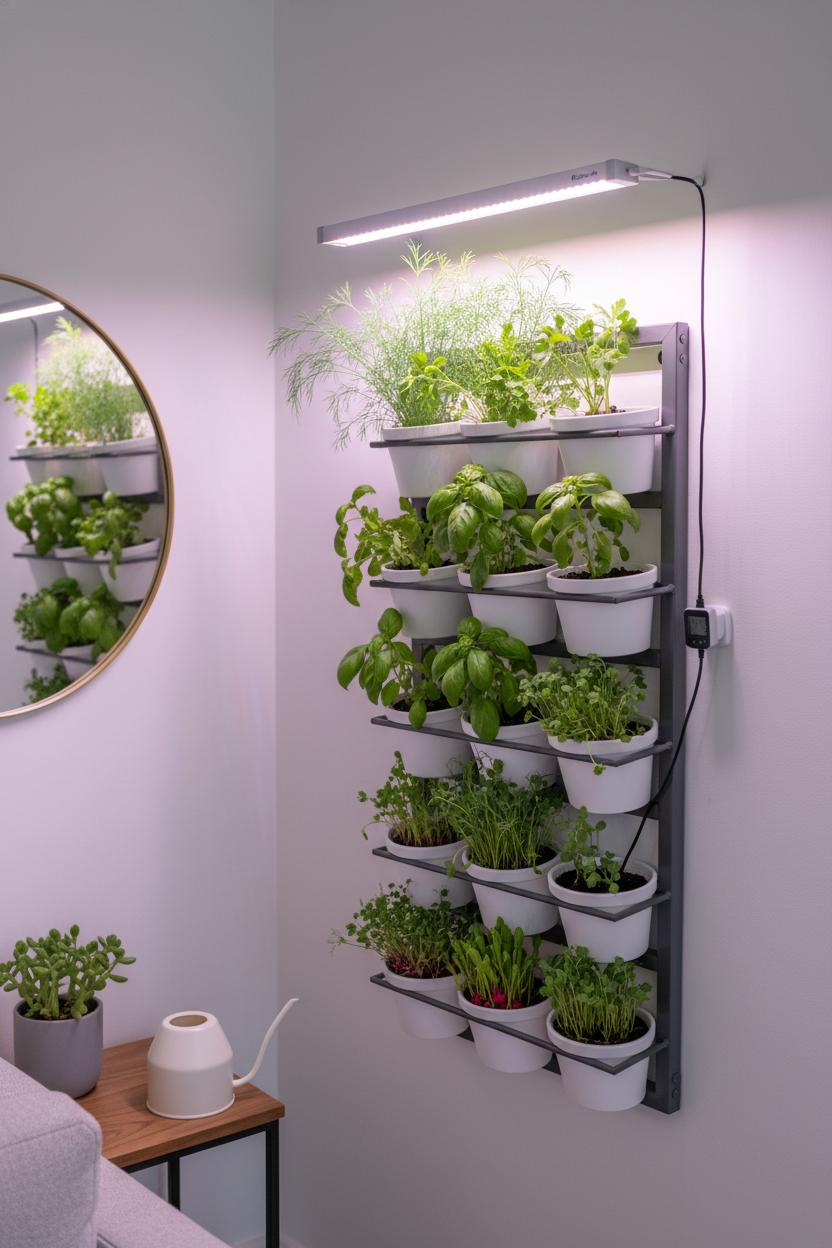
Light is the secret ingredient that makes every teeny-tiny jungle thrive, and in compact homes it’s the one resource that runs out fast. A simple way to decide when to add a grow light is to start with a quick light audit: note your window directions (south and west are brightest, north and deeply shaded courtyards are the dimmest), count how many hours of direct sun your plants actually get, and try the hand-shadow test—crisp shadows mean strong light, fuzzy shadows mean it’s time to supplement. If your herbs get leggy, your succulents stretch, leaves turn pale, or buds refuse to open, you’re seeing classic low-light clues. Winter is another cue; once days dip below 10 hours, most balcony garden setups and indoor container gardening displays appreciate a little boost, especially seedlings from an herb garden kit or tiny patio plants tucked on a bookshelf.
For small garden ideas that don’t eat up floor space, choose a slim, full-spectrum LED grow light. Clip-on or gooseneck styles tuck onto a shelf, while light bars mount under cabinets or along a vertical planter; both are brilliant for vertical gardening. Over railing planters, a lightweight bar on a timer keeps greens happy even if your view faces a wall. Aim to keep the light 6–12 inches from foliage and run it 12–14 hours for leafy herbs and microgreens, a bit less for low-light houseplants. Use a timer so your plants get a predictable “sunrise,” and bounce brightness around with white walls or a mirror to stretch every lumen in tight quarters.
Dial in the details like a pro: rotate containers weekly so growth stays even, lift pots to check soil before watering, and use a compact watering can to avoid splashes near cords. If leaves crisp, raise the light; if they reach like they’re chasing a dream, lower it or add a second bar. The beauty of a grow light is freedom—you can park basil by the kettle, strawberries on a ladder shelf, or a salad station by the sofa. Whether you’re nurturing tiny patio plants, building a balcony garden, or stacking a vertical planter indoors, thoughtful lighting turns small spaces into lush, productive corners.
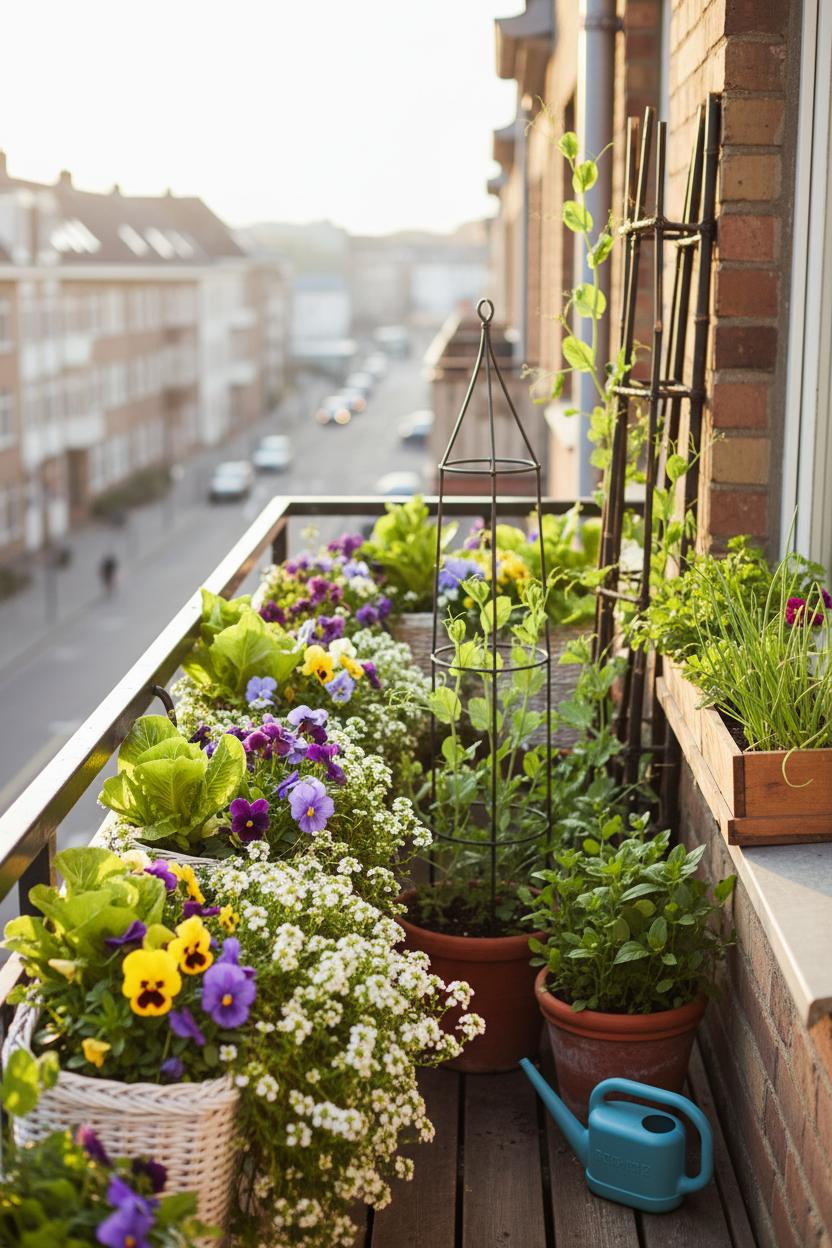
Planning by season is the secret to keeping a tiny space blooming and producing all year, and it’s easier than it sounds. In early spring, wake up your balcony garden with cool-weather charmers: tuck pansies, violas, and trailing sweet alyssum into railing planters and let them spill like confetti over the edge. Mix in leafy greens—butter lettuce, spinach, and sugar snap peas—using container gardening to your advantage so you can shuffle pots to chase the light. An herb garden kit on a sunny sill gives you instant freshness (think mint and chives for those first spring salads), and a compact watering can makes gentle, precise watering a daily ritual. If you’re short on floor space, start vertical gardening early with peas or strawberries climbing a slim vertical planter—instant height, zero clutter.
When summer arrives, lean into lush layers. Go bold with tiny patio plants that love heat: dwarf tomatoes, bush cukes, and peppers thrive in containers, while basil, thyme, and parsley fill in the gaps with fragrance and flavor. A vertical planter becomes your living pantry—slot in cascading cherry tomatoes, nasturtiums for edible flowers, and trailing petunias for nonstop color. For a punchy balcony garden display, pair sun-loving zinnias with compact marigolds to invite pollinators, and keep salad bowls going with cut-and-come-again greens tucked under taller plants. Railing planters are perfect for strawberries and trailing herbs, turning every inch of edge space into a harvest. Morning watering with that compact watering can keeps foliage dry and happy through hot afternoons.
As days cool, swap in autumn stars: kale, Swiss chard, dwarf mums, and ornamental peppers bring saturated color and texture. Plant garlic and spring bulbs in deep containers now for a surprise show later, and let hardy rosemary anchor the display. For winter, think structure and sparkle—evergreen herbs, dwarf conifers, cyclamen, and violas carry on in mild climates, while inside you can keep harvesting with microgreens and compact lettuces under a discreet grow light. Bring tender herbs indoors from your container gardening lineup and park them on a bright shelf; that same herb garden kit shifts seasons beautifully. With a little rotation and a touch of vertical gardening, these small garden ideas turn even the tiniest patio plants into a four-season parade of color and kitchen-ready goodness.
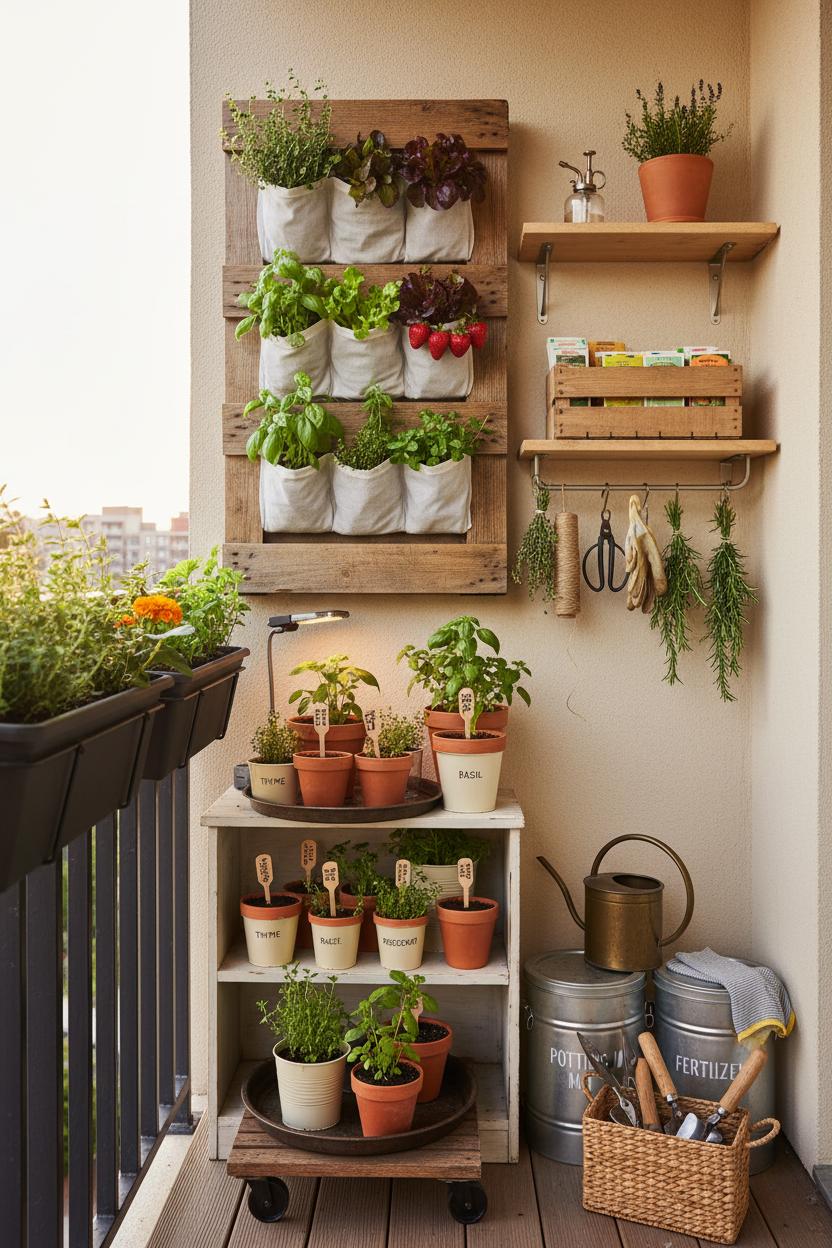
If your balcony garden is feeling more chaotic than charming, a few budget-friendly tweaks can make it look styled on purpose. Start by corralling the visual clutter: choose two or three materials—think raw wood, matte black metal, and terracotta—and stick with them so pots, tools, and trays feel coordinated. Railing planters instantly clear floor space and frame the view, while a narrow thrifted bookshelf or a pair of floating ledges turns a blank wall into a mini plant pantry. Tuck a compact watering can into a basket by the door, decant soil into lidded bins, and gather hand tools in a pretty caddy so you’re not hunting between cushions. These small garden ideas are all about editing and elevating what you already have.
For vertical gardening on a budget, repurpose a wooden pallet or a canvas shoe organizer as a slim vertical planter—line it with landscape fabric, add potting mix, and slip in herbs and strawberries for a lush, living tapestry. An inexpensive herb garden kit can jump-start your planting and keep the palette cohesive; use matching terracotta or painted tins for container gardening so even mismatched finds feel intentional. Pop tiny patio plants like thyme, dwarf marigolds, and trailing oregano into petite pots and cluster them by height for a layered look. Label everything with paint pens or wooden tags, and slide saucers onto inexpensive plant caddies or old baking sheets to keep drips from marking the floor. If your space is shady, a simple clip-on grow light will keep basil perky and lettuce crisp without crowding your setup.
Storage doubles as decor when you think vertically and hide the utilitarian bits in plain sight. Hooks under shelves hold a mister, twine, and scissors; a tension rod becomes a drying rack for herbs; and a shallow crate mounted sideways makes a charming cubby for seed packets and gloves. Use S-hooks to hang a spray bottle and a folding pruning knife, stash fertilizer in labeled jars, and keep a microfiber cloth handy to wipe leaves and railings in one swoop. With a few intentional upgrades and materials you can thrift or reclaim, your balcony garden will look serene, stay easy to maintain, and give you that clever, curated glow every tiny space deserves.

Keeping a small space lush doesn’t have to mean high-maintenance routines—think gentle, consistent care. In container gardening, pruning is your shortcut to tidy, happy growth. Make a habit of a quick “morning coffee walk” through your balcony garden or tiny patio plants and pinch back leggy stems, snip spent blooms, and remove yellowing leaves. This keeps energy flowing to new growth and improves airflow (a must in vertical gardening where foliage can crowd). Trailing herbs and cherry tomatoes in a vertical planter appreciate a light trim every week, while bushy annuals in railing planters love regular deadheading. Rotate pots a quarter turn every few days so stems grow evenly, and don’t be shy about shaping—containers are forgiving, and compact plants look intentional in small garden ideas.
Feeding can stay simple, too. Start with a high-quality potting mix, then top up monthly with a gentle, slow-release fertilizer or a sprinkle of worm castings; liquid seaweed or fish emulsion every 2–4 weeks keeps greens perky without burning roots. Herbs from an easy herb garden kit thrive on light, regular nourishment—too much and they lose flavor. Water deeply but less often so roots reach down; a compact watering can helps you aim at the soil, not the leaves, to prevent disease. If your balcony gets partial shade, tuck a slim grow light near your most light-hungry containers to stretch the day and keep foliage dense. Refresh the top inch of soil each season and upsize crowded pots to keep nutrients flowing and plants stress-free.
For low-fuss pest control, think prevention and quick action. Check leaf undersides weekly; early aphids or mites wipe off with a damp cloth or a spritz of soapy water. A neem oil spray every couple of weeks is a gentle shield for edibles, and sticky traps near tomatoes and peppers catch gnats before they multiply. Keep leaves from touching by spacing pots in your vertical planter, and water in the morning so surfaces dry fast. Tuck pest-repelling herbs—basil, mint, chives—among containers to deter troublemakers naturally. Quarantine any new plant for a week before joining the party on your balcony garden, and you’ll keep your tiny oasis thriving with minimal effort.
From layered shelves to hanging pots, these small garden ideas prove even the tiniest nook can bloom. Mix vertical gardening with container gardening to grow herbs, blooms, and greens without sacrificing floor space. Style a sunny balcony garden or refresh a narrow entry with tiny patio plants, fairy lights, and cozy seating for instant retreat vibes. Start with one planter, add height, and let your mini oasis evolve season by season. Your compact corner is ready to thrive—just plant, sip, and enjoy the green glow at home.